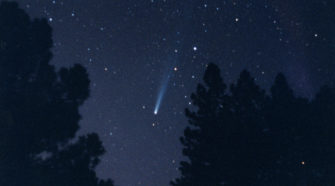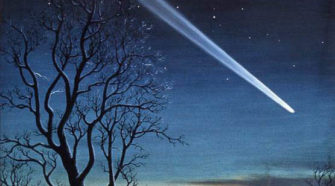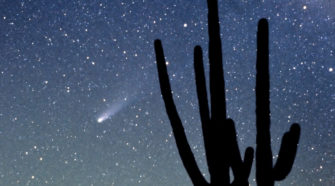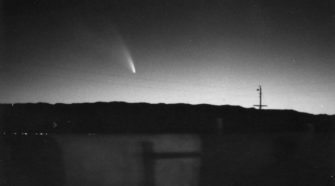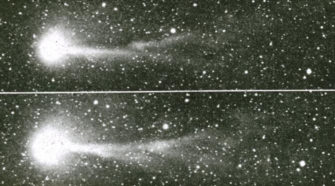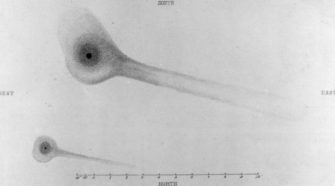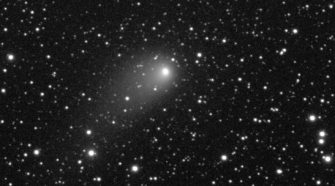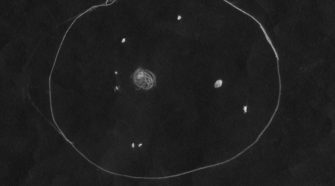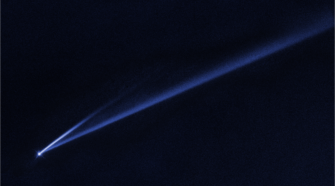Comet
Comet of the Week: Hyakutake C/1996 B2
Perihelion: 1996 May 1.40, q = 0.230 AU Following the discovery of Comet Hale-Bopp in mid-1995, the entire world was awaiting its expected good show in 1997. But while we were waiting, another comet came by and provided another stunning show. This object was discovered on January 30, 1996 by a Japanese amateur astronomer, Yuji …
Comet of the Week: The Great Comet of 1843
Perihelion: 1843 February 27.91, q = 0.006 AU For the first time in “Ice and Stone 2020,” a Kreutz sungrazer is my “Comet of the Week.” Some of the members of this group of comets have been among the brightest and most spectacular comets in all of recorded history, and as a group they are …
Comet of the Week: 1P/Halley 1981i
Perihelion: 1986 February 9.46, q = 0.587 AU Those of us space-minded people who came of age during the middle decades of the 20th Century learned of Comet Halley and its impending return in 1986, and many of us undoubtedly heard stories of its appearance during its excellent return in 1910; my paternal grandmother, an …
Comet of the Week: West 1975n
Perihelion: 1976 February 25.22, q = 0.197 AU What I consider to be the best comet I have ever seen was missed by most of the general public. Part of this was due to the fact that it put on its best appearance in the sleepy hours before dawn, but a large part of it …
Comet of the Week: Whipple-Fedtke-Tevzadze 1942g
Perihelion: 1943 February 6.72, q = 1.354 AU The name of Fred Whipple is legendary in cometary astronomy. He spent several decades as an astronomer and professor at Harvard University, and is best known for developing what he called the “icy conglomerate” model of a comet’s nucleus (more commonly referred to as the “dirty snowball”) …
Comet of the Week: 3D/Biela 1846 II
Perihelion: 1846 February 11.49, q = 0.856 AU The stories of the first two numbered periodic comets, 1P/Halley and 2P/Encke – both of which are future “Comets of the Week” – are well known. The third numbered periodic comet also has an interesting story, but unlike the earlier two, it will likely never be seen …
Comet of the Week: PANSTARRS C/2017 T2
Perihelion: 2020 May 4.95, q = 1.615 AU After devoting my “Comet of the Week” last week to the first comet I ever observed, it seems appropriate to devote this week’s “Comet of the Week” to the brightest comet that is currently visible in our nighttime skies, and which is easily accessible for observations, at …
Comet of the Week: Tago-Sato-Kosaka 1969g
Perihelion: 1969 December 21.27, q = 0.473 AU Everyone fondly remembers their “first.” When it comes to comets, my “first” came exactly 50 years ago on Monday evening, February 2, 1970, when I was 11 years old and in the 6th Grade, and involved a 5th-magnitude fuzzball located close to the 2nd-magnitude star Hamal in …
Comet of the Week: The Daylight Comet of 1910
Perihelion: 1910 January 17.59, q = 0.129 AU In early 1910 the entire world – astronomers and lay public alike – awaited the imminent return of Comet 1P/Halley, which had been recovered the previous September and which was already detectable with moderate-sized telescopes. While Halley would go on to put on a spectacular display around …
Comet of the Week: (6478) Gault
Perihelion: 2020 January 2.79, q = 1.859 AU It has been obvious for several decades that the dividing line between “comets” and “asteroids” is, in a word, nebulous, and some facets of this will be explored in future “Special Topics” presentations. One group of objects that are included within this discussion were initially referred to …

